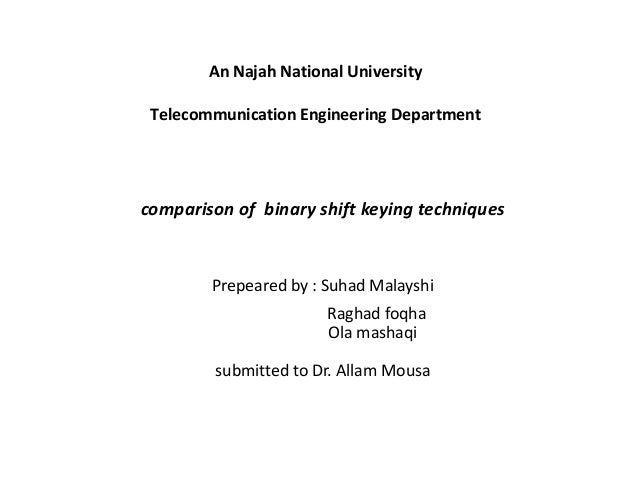Ask Fsk Psk
Quite often we have to send digital data through analog transmission media such as a telephone network. In such situations it is essential to convert digital data to analog signal.
ASK, PSK and FSK are signaling schemes used to transmit binary sequences through free space. In these schemes, bit-by-bit transmission through free space occurs. FSK (Frequency Shift Keying): In FSK (Frequency Shift Keying) binary 1 is represented with a high-frequency carrier signal and binary 0 is represented with a low-frequency carrier, i.e. ASK,FSK and M-PSK modulated signals are produced using MATLAB software and Simulink. The coding for MATLAB are troubleshoot from the questions given to produce modulated signals. For ASK, FSK and PSK amplitude, frequency and phase of carrier signal is varied to represent binary 1 and 0 respectively. Deepesh Rawat September 28, 2013. Digital Modulation Techniques (ASK, FSK And PSK)%matlab code for digital modulation (ask, fsk and psk) f=5; f2=10; x= 1 1 0 0 1 0 1 0% input signal; nx=size (x,2); i=1. This post discusses Digital Modulation Techniques (ASK, FSK and PSK). The Waveforms, Definition and Basic Concepts of each digital modulation Techniques are discussed here. You will find here the basic difference between digital modulation and analog modulation. The digital modulation techniques are amplitude shift keying (ASK), frequency shift keying (FSK) and Phase shift keying (PSK). ASK, FSK or PSK Which is the best? RF Engineering Telecommunications Data Communication Communication Systems الاتصالات السلكية واللاسلكية. Question added by هاشم المشارقة, Projects Sales Engineer, DASH Control Systems Co. Date Posted: 2014/07/09.
Basic approach is shown in Figure below. This conversion is accomplished with the help of special devices such as modem (modulator-demodulator) that converts digital data to analog signal and vice versa.
ASK, FSK, and PSK with Neat Diagram
Digital to Analog conversion
Digital data needs to be carried on an analog signal.

A carrier signal (frequency fc) performs the function of transporting the digital data in an analog waveform.
Amplitude Shift Keying (ASK)
ASK is implemented by changing the amplitude of a carrier signal to reflect amplitude levels in the digital signal.
For example: a digital could not affect the signal, whereas a digital would, by making it zero.
Frequency Shift Keying(FSK)
The two binary values are represented by two different frequencies
Phase Shift Keying (PSK)
The phase of carrier signal is shifted to represent the data.
In PSK , the phase is varied to represent binary 1 or 0.
- Digital Communication Tutorial
- Digital Communication Resources
- Selected Reading
Amplitude Shift Keying (ASK) is a type of Amplitude Modulation which represents the binary data in the form of variations in the amplitude of a signal.
Any modulated signal has a high frequency carrier. The binary signal when ASK modulated, gives a zero value for Low input while it gives the carrier output for High input.
The following figure represents ASK modulated waveform along with its input.
To find the process of obtaining this ASK modulated wave, let us learn about the working of the ASK modulator.
ASK Modulator
The ASK modulator block diagram comprises of the carrier signal generator, the binary sequence from the message signal and the band-limited filter. Following is the block diagram of the ASK Modulator.
Ask Fsk Psk Mcq
The carrier generator, sends a continuous high-frequency carrier. The binary sequence from the message signal makes the unipolar input to be either High or Low. The high signal closes the switch, allowing a carrier wave. Hence, the output will be the carrier signal at high input. When there is low input, the switch opens, allowing no voltage to appear. Hence, the output will be low.

The band-limiting filter, shapes the pulse depending upon the amplitude and phase characteristics of the band-limiting filter or the pulse-shaping filter.
ASK Demodulator
Ask Fsk Psk
There are two types of ASK Demodulation techniques. They are −
- Asynchronous ASK Demodulation/detection
- Synchronous ASK Demodulation/detection

The clock frequency at the transmitter when matches with the clock frequency at the receiver, it is known as a Synchronous method, as the frequency gets synchronized. Otherwise, it is known as Asynchronous.
Asynchronous ASK Demodulator
The Asynchronous ASK detector consists of a half-wave rectifier, a low pass filter, and a comparator. Following is the block diagram for the same.
The modulated ASK signal is given to the half-wave rectifier, which delivers a positive half output. The low pass filter suppresses the higher frequencies and gives an envelope detected output from which the comparator delivers a digital output.
Synchronous ASK Demodulator
Synchronous ASK detector consists of a Square law detector, low pass filter, a comparator, and a voltage limiter. Following is the block diagram for the same.
The ASK modulated input signal is given to the Square law detector. A square law detector is one whose output voltage is proportional to the square of the amplitude modulated input voltage. The low pass filter minimizes the higher frequencies. The comparator and the voltage limiter help to get a clean digital output.